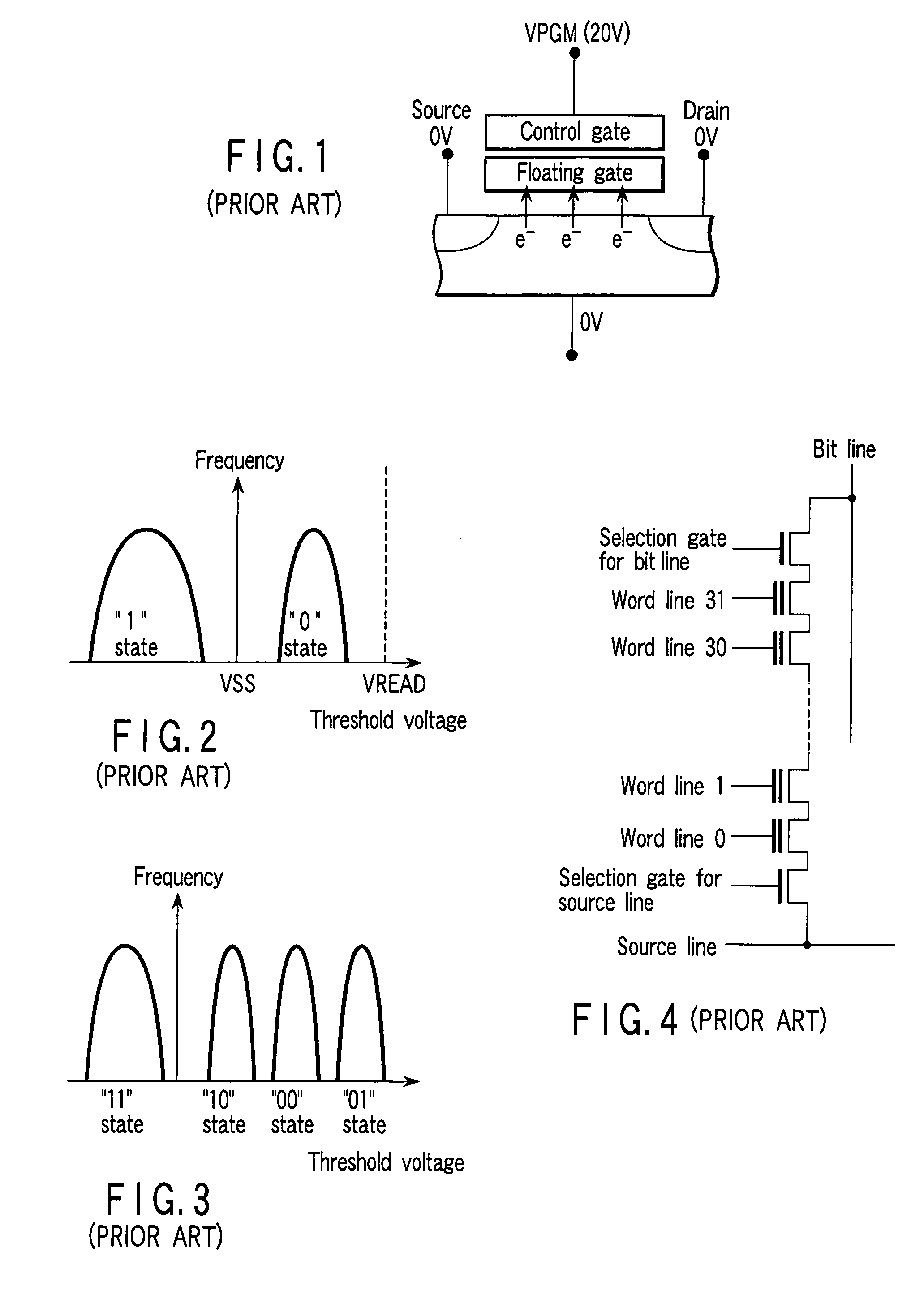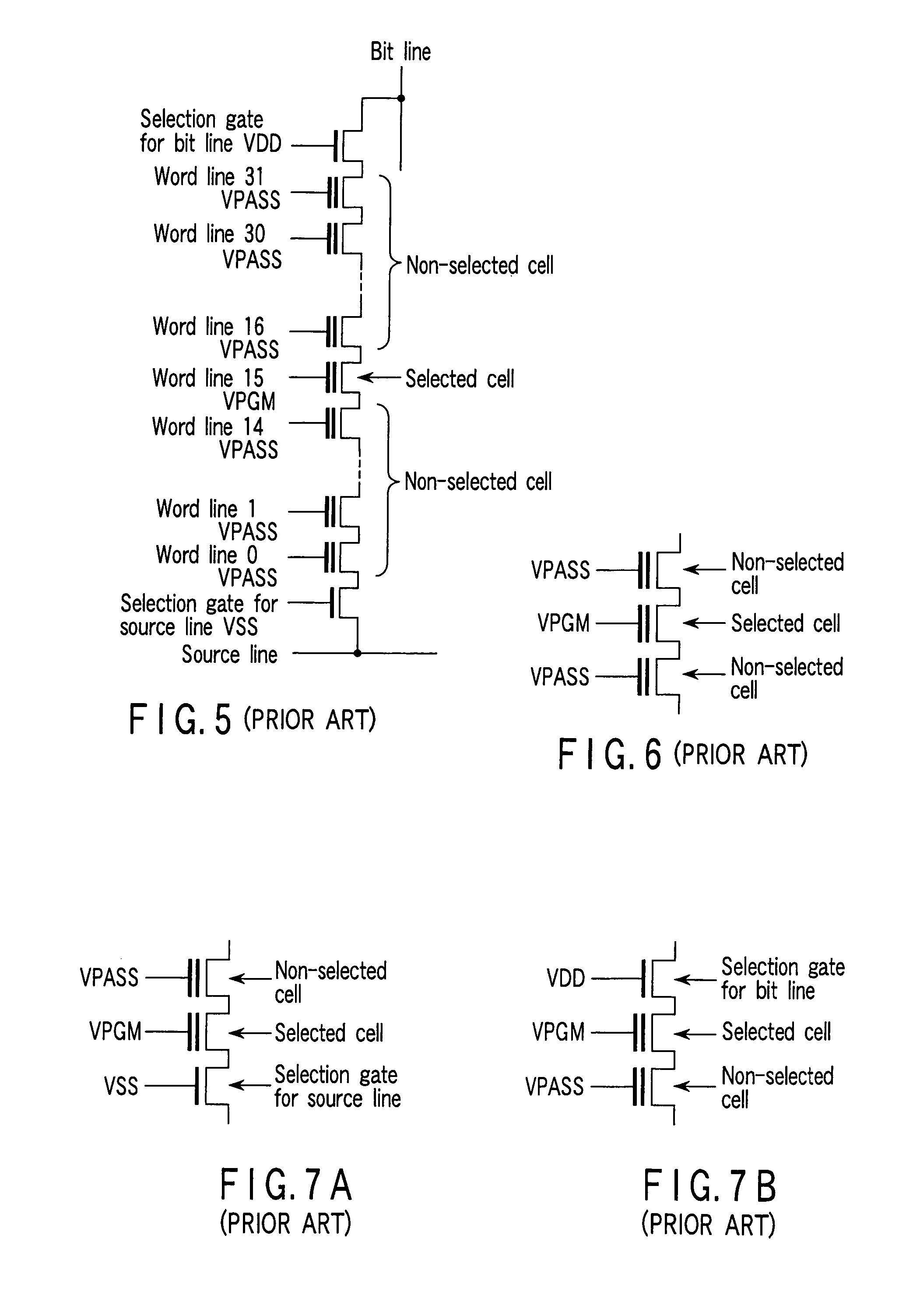NAND-structured flash memory
a flash memory and structure technology, applied in the field of nonvolatile semiconductor memory devices, can solve the problems of erroneous writing, low performance, and complex control circuits,
- Summary
- Abstract
- Description
- Claims
- Application Information
AI Technical Summary
Benefits of technology
Problems solved by technology
Method used
Image
Examples
first embodiment
[0064]Before describing the embodiments, a bias condition in writing into a NAND-structured flash memory is shown in FIG. 1 to reconfirm characteristics of the NAND-structured flash memory. In this method, a channel is fixed at ground potential, and a high potential (hereinafter referred to as VPGM) is applied to a control gate which is a word line, so as to pull electrons from the entire channel, and store the electrons in a floating gate. A threshold value of a memory cell transistor changes in accordance with the amount of electric charge stored in the floating gate.
[0065]As shown in FIG. 2, in a NAND structure using a binary cell, a state in which electrons are stored in the floating gate and a state in which electrons are not stored are identified to store one bit. Further, as shown in FIG. 3, in a NAND structure using a multi-level cell, the threshold value of the memory transistor which changes in accordance with the amount of electric charge stored in the floating gate is id...
second embodiment
[0082]The NAND-structured flash memory in a second embodiment is a quaternary NAND-structured flash memory, and as shown in FIG. 11, one NAND string is composed of the bit line side selection gate (selection transistor), 36 memory cells, and the source line side selection gate. The four memory cells including two next to the bit line side selection gate and two next to the source line side selection gate are treated as dummy cells (dummy gates), and the remaining 32 memory cells are treated as quaternary cells. As the two dummy cells are disposed next to the selection gate, it is possible to have a more uniform bias condition in the operation of writing into the quaternary cells than in the first embodiment.
[0083]The circuit in FIG. 10 of the first embodiment can be utilized directly as a word line voltage control circuit. In addition, a quaternary memory cell is also used for the dummy cell in the second embodiment, but a memory cell higher than the quaternary level such as the oct...
third embodiment
[0084]The NAND string in a third embodiment has the same configuration as that in the second embodiment, but a control gate charging voltage for the dummy cells adjacent to the selection gates is lower (e.g., 2.5 V) than the ordinary non-selected word line voltage (e.g., 14 V). This makes it possible to keep the effects of the coupling noise lower, which are caused to the selection gate when the control gate is charged.
[0085]FIG. 12 is a circuit diagram of the word line voltage control circuit (word line driving circuit) capable of the operation described above. The difference from the word line voltage control circuit in FIG. 10 is that a first dummy word line voltage generator 6, a second dummy word line voltage generator 7, a first dummy word line voltage selection circuit 8 and a second dummy word line voltage selection circuit 9 are added. As two dummy word line voltage generators are provided, the bit line side dummy gate and the source line side dummy gate can be driven at di...
PUM
 Login to View More
Login to View More Abstract
Description
Claims
Application Information
 Login to View More
Login to View More - R&D
- Intellectual Property
- Life Sciences
- Materials
- Tech Scout
- Unparalleled Data Quality
- Higher Quality Content
- 60% Fewer Hallucinations
Browse by: Latest US Patents, China's latest patents, Technical Efficacy Thesaurus, Application Domain, Technology Topic, Popular Technical Reports.
© 2025 PatSnap. All rights reserved.Legal|Privacy policy|Modern Slavery Act Transparency Statement|Sitemap|About US| Contact US: help@patsnap.com



